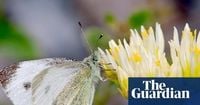Britain’s ever-changing landscape of butterflies has a new arrival, and it’s causing quite a stir among conservationists and nature lovers alike. The Southern Small White butterfly, previously a resident only of southern Europe, has been officially spotted in the United Kingdom for the very first time. This sighting, confirmed in the summer of 2025, marks a remarkable milestone in the butterfly’s rapid journey northward—a journey that scientists say is intimately tied to a warming climate and shifting habitats.
According to Butterfly Conservation, the charity at the forefront of tracking butterfly populations across the UK, the Southern Small White (scientifically known as Pieris mannii) had never before been recorded on British soil. That changed on August 2, 2025, when Will Brame, a keen-eyed volunteer at Landguard Bird Observatory in Suffolk, managed to snap a photo of a delicate white butterfly clinging to a yellow flower. Just a month earlier, birdwatcher Martyn Sidwell had spotted a similar butterfly in Hartlepool, County Durham. Both sightings were verified by Chris van Swaay, chair of Butterfly Conservation Europe, who’s been tracking the northward march of this species for years (BBC, The Guardian, Woking News & Mail).
“This is really exciting,” said Dr Dan Hoare, Director of Nature Recovery at Butterfly Conservation, in an interview with The Guardian. “It’s always interesting when a new species turns up in the UK, but the Southern Small White has been gradually moving northwards through Europe for over a decade and we were just waiting for it to be seen in England for the first time. Top marks to the eagle-eyed snappers who not only got photos, but also realised the significance of what they’d seen.”
The Southern Small White’s expansion is nothing short of dramatic. Once confined to southern and south-eastern Europe, the butterfly began its northward trek in earnest in 2008, when it was first spotted north of the Alps in France and Germany. By 2015, it had reached the Netherlands, and by 2019, records placed it near Calais in northern France. Its journey hasn’t slowed down—the species is now moving north at a rate of about 100 kilometers (62 miles) per year, according to Dr Hoare (BBC, Woking News & Mail).
But what’s driving this rapid colonisation? Scientists point to a warming climate as a key factor. The UK’s spring of 2025 was the warmest and sunniest on record, and such conditions are believed to have played a major role in the butterfly’s arrival. “We always love to see butterflies and moths doing well in the UK, but we also know there are going to be winners and losers from the very rapid climate change we’re experiencing,” Dr Hoare told The Guardian. He added, “One way we can increase the number of climate winners is by managing habitats positively so that threatened species can benefit as well as widespread mobile species. That means creating and maintaining good quality, connected habitat at a landscape scale.”
Spotting the Southern Small White isn’t easy for the untrained eye. It looks remarkably similar to native white butterflies like the Small White, Large White, and Green-veined White. However, experts note that the Southern Small White can be distinguished by subtle differences in the black markings on its forewing tips. On this species, the black marks are square in shape and reach down the outside of the wing to a point level with a black spot further in from the border (The Guardian, BBC). For those hoping to spot one, free identification apps such as ObsIdentify are helping, provided a clear photo can be taken.
As for its future in the UK, things are still uncertain. The butterfly’s caterpillars feed on candytuft, an evergreen shrub that is popular among gardeners but not as widely planted as the brassicas that support other white butterfly species. “Whether the species stays long term is yet to be seen, as its food source is a garden species called Candytuft that is not as widely planted here,” Dr Hoare explained to the BBC. The Southern Small White has not yet been recorded breeding in the UK, a crucial step for it to become a true resident rather than just an occasional visitor.
The arrival of the Southern Small White is not the only sign that the UK’s butterfly and moth populations are responding to changing conditions. The 2025 Big Butterfly Count, run by Butterfly Conservation, reported a surge in sightings of the Jersey Tiger moth—a species that just a decade ago was restricted to the Channel Islands and the south coast of England. By mid-summer 2025, 5,300 Jersey Tiger moths had been recorded, compared to 3,496 for the whole of the previous summer. These striking moths, with their bold black and white striped forewings and red hindwings, have now been spotted as far north as Cardiff, Birmingham, Cambridgeshire, and Essex (Woking News & Mail).
Experts believe that Britain’s record-breaking warm, dry spring helped both butterflies and moths spread their wings in new parts of the country. The influx of new species and the northward march of familiar ones are both exciting and sobering. While it’s thrilling to see new arrivals, scientists caution that not all species will fare equally well as the climate continues to change. Some, like the Southern Small White and Jersey Tiger moth, appear to be thriving, while others may struggle to keep pace with shifting habitats and weather patterns.
Butterfly Conservation is urging the public to play a role in supporting these changes. Gardeners, in particular, can help by planting candytuft and other butterfly-friendly plants, creating habitats that could support both new arrivals and native species. The charity’s website offers tips for identifying butterflies and moths, as well as advice on how to turn gardens and green spaces into havens for pollinators (Woking News & Mail).
For those captivated by the idea of spotting a Southern Small White, patience and a keen eye are essential. The differences between it and the common Small White are so subtle that even experienced observers can be fooled. As one local naturalist put it after examining photos side by side, “I have to say the differences are so subtle that, had I seen a Southern Small White, I would have dismissed it as a common Small White — of which I’ve seen very many this summer” (Woking News & Mail).
Whether the Southern Small White becomes a permanent fixture in Britain’s gardens and meadows remains to be seen. For now, its arrival is a vivid reminder that nature is always on the move, adapting and responding to the world’s changing climate—sometimes in ways that surprise even the experts.




